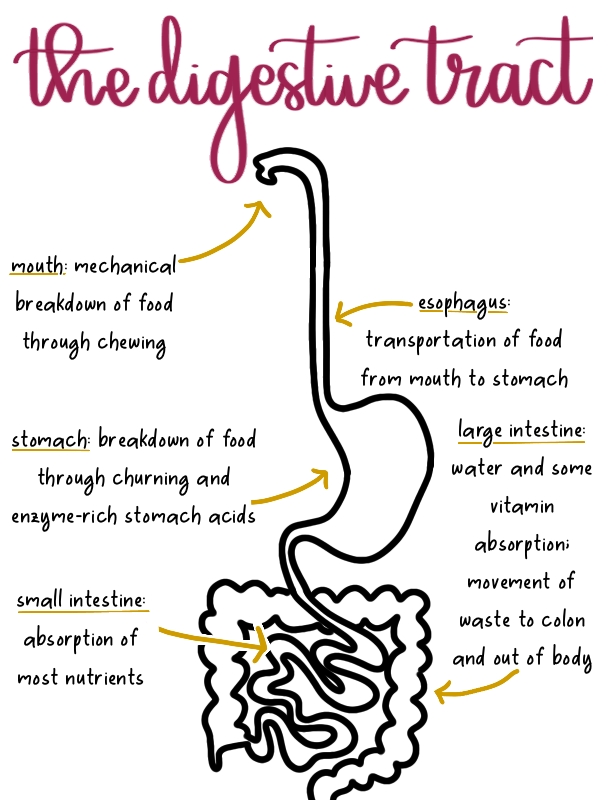By Abby Caudle-Patton
Abby is a second-year master’s student in Nutrition and Dietetics at Meredith College in Raleigh, NC. Abby currently works at a recovery center and enjoys reading, trying new recipes, exploring local trails, and snuggling with her pups.
A Brief Background on Digestion and Absorption
Eating disorders can cause physical and emotional consequences to those who suffer from them. One common physical complaint from those battling an eating disorder is gastroparesis, or “delayed gastric emptying.”

Here is a little lesson on how your body breaks down and takes in food for energy, also known as digestion and absorption:
After chewing and swallowing food, it travels through the esophagus and into the stomach where it will be digested by the stomach muscles (mechanical digestion) and stomach acids (enzymatic digestion).
This, now unrecognizable, food is then sent out of the stomach through the small intestine.
The muscles in the small intestine move like a snake, inching partially digested food through the “tube” and eventually into the large intestine and out of the body.
However, without consistently eating enough food, the muscles along the small intestine become weaker (“atrophy”), making it difficult for digestion and absorption to take place efficiently.
This atrophy reduces the small intestine’s ability to push the food (which is ready to be absorbed) and food byproducts (what will soon be poop!) through the tubing of the small intestines and then into the large intestine to be removed from the body. Food matter has to be “bulky” to push against the muscles in the small intestine. Without bulk, the muscles are not signaled to push the food through.
Caloric restriction reduces the physical mass of food that is moving along the digestive tract. This eventually causes food byproducts to linger in the digestive tract for a long period of time and become hardened and difficult to pass.
Caloric restriction also sends signals to the body to halt nonessential bodily functions (ie: sexual reproduction) and slow others in order to reserve energy just to stay alive.
The only way to “wake up” these muscles and signal that the body is ready to digest and absorb food consistently is to adequately nourish yourself!
Signs and Symptoms of Delayed Gastric Emptying
Delayed gastric emptying may be the culprit of a lot of common gastrointestinal complaints in those with an eating disorder. Signs of delayed gastric emptying include:
- Vomiting
- Nausea
- Pain and bloating
- Lingering fullness, even hours after a meal or snack
- Acid reflux
- Constipation
Relief and Remedies
As with any physiologic (or psychologic!) condition, it is always best to consult a trusted healthcare professional to be safe. In the meantime, here are some remedies that may help to alleviate the discomfort that stems from delayed gastric emptying.
- Eat regular meals and snacks: Often, delayed gastric emptying can make you feel really full, even hours after a meal. Your eating disorder may make it hard for you to feel your hunger and fullness cues. This reduced awareness of these cues along with the delayed gastric emptying can make sticking to a meal plan or consistently nourishing yourself really difficult. It seems somewhat counterintuitive to continue to eat your next meal or snack when you are still feeling full from a previous meal or snack. However, it is important to have adequate intake for digestion to move along more quickly. This may be uncomfortable both physically and mentally but it is so important to increase digestive efficiency! While other remedies on this list may help alleviate discomfort caused by delayed gastric emptying, regular food consumption is an important step to tackle the root causes of this condition.
- Aim for adequate hydration: When food lingers in the intestines, water is often reabsorbed into the body. This causes fecal mass to become dry and less lubricated and results in even more difficult movement through the intestinal tract. Keep a water bottle with you through the day and be mindful of urine color to check hydration status.
- Avoid laying down directly after eating: Experts recommend staying upright after consuming a meal or snack to keep your digestive system “awake” and ready to work!
- Try a warm pack / heating pad: Applying a warm pack or heating pad to the abdominal area may bring temporary relief to any pain caused by delayed gastric emptying.
- Abdominal massage: Abdominal massages may help the digestive system get going! See this handout from the Michigan Bowel Control Program for instructions.
Complications and When to See a Provider
Delayed gastric emptying can become dangerous after time. Dehydration, hardened fecal mass, and potential impact on blood sugar are side effects that can jeopardize your health and wellbeing. It is important to discuss all physical side effects with your doctor or physician as well as your dietitian to make sure you are not at risk for any of these more dangerous complications of delayed gastric emptying. Being honest and vulnerable about your eating disorder, including physical side effects, is one of the bravest (and safest!) things you can do in your recovery journey!
If you or a loved-one is struggling with disordered eating behaviors, contact Not Your Average Nutritionist to see how they can help you have a better relationship with food. Full recovery is possible!




